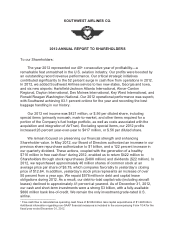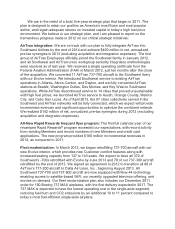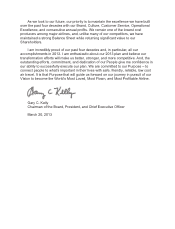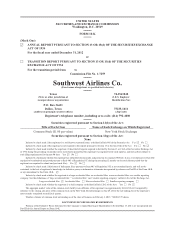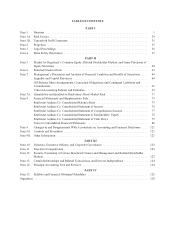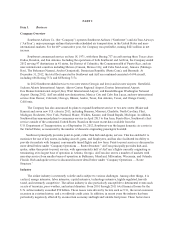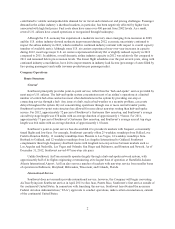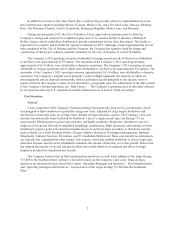Southwest Airlines 2012 Annual Report Download - page 11
Download and view the complete annual report
Please find page 11 of the 2012 Southwest Airlines annual report below. You can navigate through the pages in the report by either clicking on the pages listed below, or by using the keyword search tool below to find specific information within the annual report.In addition to service to San Juan, Puerto Rico, AirTran also provides service to eight destinations in six
near-international countries including Mexico (Cancun, Mexico City, and Cabo San Lucas), Jamaica (Montego
Bay), The Bahamas (Nassau), Aruba (Oranjestad), Dominican Republic (Punta Cana), and Bermuda.
During second quarter 2012, the City of Houston, Texas, approved an expansion plan to allow the
Company to design and construct five additional gates and a U.S. customs facility at Houston’s William P.
Hobby Airport, which would allow Southwest to provide international service from that airport. The facility is
expected to be complete and available for operation sometime in 2015. Although a formal agreement has not yet
been completed by the City of Houston and the Company, the Company has agreed to fund the design and
construction of this project, which is currently estimated, by the City of Houston, to cost $156 million.
The Company’s 2012 operating revenues attributable to foreign operations (all of which were attributable
to AirTran) were approximately $159 million. The remainder of the Company’s 2012 operating revenues,
approximately $16.9 billion, were attributable to domestic operations. The Company’s 2011 operating revenues
attributable to foreign operations (all of which were attributable to AirTran) were approximately $74 million. The
remainder of the Company’s 2011 operating revenues, approximately $15.6 billion, were attributable to domestic
operations. The Company’s tangible assets primarily consist of flight equipment, the majority of which are
interchangeable and are deployed systemwide, with no individual aircraft dedicated to any specific route or
region; therefore the Company’s assets are not allocated to a geographic area. For a discussion of the risks related
to the Company’s foreign operations, see “Risk Factors — The Company’s operations may be adversely affected
by its expansion into non-U.S. jurisdictions and the related increase in laws to which it is subject.”
Cost Structure
General
A key component of the Company’s business strategy has historically been its low-cost structure, which
was designed to allow Southwest to profitably charge low fares. Adjusted for stage length, Southwest and
AirTran have lower unit costs, on average, than virtually all major domestic carriers. The Company’s low-cost
structure has historically been facilitated by Southwest’s use of a single aircraft type, the Boeing 737, an
operationally efficient point-to-point route structure, and highly productive Employees. Southwest’s use of a
single aircraft type has allowed for simplified scheduling, maintenance, flight operations, and training activities.
Southwest’s point-to-point route structure includes service to and from many secondary or downtown airports
such as Dallas Love Field, Houston Hobby, Chicago Midway, Baltimore-Washington International, Burbank,
Manchester, Oakland, San Jose, Providence, and Ft. Lauderdale/Hollywood. These conveniently located airports
are typically less congested than other airlines’ hub airports, which has enabled Southwest to achieve high asset
utilization because aircraft can be scheduled to minimize the amount of time they are on the ground. This in turn
has reduced the number of aircraft and gate facilities that would otherwise be required and allows for high
Employee productivity (headcount per aircraft).
The Company believes that its fleet modernization initiatives, as well as the addition of the larger Boeing
737-800 to the Southwest fleet, will have a favorable impact on the Company’s unit costs. These strategic
initiatives are discussed in more detail below under “Operating Strategies and Initiatives – Fleet Modernization”
and “Operating Strategies and Initiatives – Incorporation of the Larger Boeing 737-800 into the Southwest
Fleet.”
3

